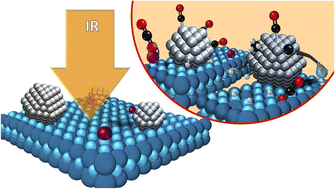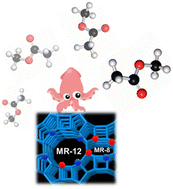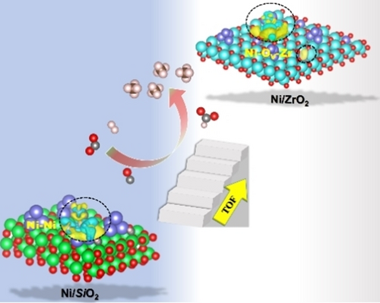Scientific Papers in SCI
2024
2024
Química de Superficies y Catálisis
Subnanometric Pt clusters dispersed over Cs-doped TiO2 for CO2 upgrading via low-temperature RWGS: operando mechanistic insights to guide an optimal catalyst design
Torres-Sempere, G; Blay-Roger, R; Luque-Alvarez, LA; Santos, JL; Bobadilla, LF; Pastor-Pérez, L; Centeno, MA; Hernández, WY; Yousef, I; Odriozola, JA; Reina, TRJournal of Matertials Chemistry A, 12 (2024) 1779-1792
Show abstract ▽

The RWGS reaction is gathering momentum as an effective route for CO2 valorisation and given its endothermic nature the challenge lies in the design of active low-temperature catalysts. Herein we have designed two catalysts based on subnanometric Pt clusters providing effective CO2 conversion and, more importantly, high CO selectivity in the low-temperature range. The impact of Cs as a dopant in the catalyst's formulation is crucial leading to full selectivity at 300 °C. The reaction mechanisms for the studied systems namely Pt/TiO2 and PtCs/TiO2 are significantly different due to the presence of the alkali promoter. The presence of Cs neutralises the hydroxide groups of the TiO2 surface, changing the reaction pathway. The Pt/TiO2 catalyst follows a redox mechanism where CO2 dissociates to CO in the oxygen vacancies, and then these vacancies are recovered by the migration of H2 by spill over phenomena. On the other hand, the Cs doped catalyst has two possible mechanism pathways: the (ii) formyl/acyl pathway, where –CHO species are formed and, depending on the reaction conditions, evolve to CO gas or oxygenated compounds, and (ii) frustrated Lewis pair (FLP) assisted CO2 reduction route, in which the FLP induces the heterolytic dissociation of H2 and the subsequent hydrogenation of CO2 to CO. The latter route enabled by Cs-doping combined with the subnanometric Pt domains seems to be responsible for the excellent catalytic behaviour leading to fully selective low-temperature RWGS systems and thus unlocking new possibilities for less energy demanding CO2 valorisation units based on RWGS.
January, 2024 | DOI: 10.1039/D3TA05482A
Materiales Ópticos Multifuncionales
Scattering Spheres Boost Afterglow: A Mie Glass Approach to Go Beyond the Limits Set by Persistent Phosphor Composition
Castaing, V; Romero, M; Torres, J; Lozano, G; Míguez, HAdvanced Optical Materials, 12 (2024) 2301565
Show abstract ▽
Persistent luminescence phosphor nanoparticles (PersLNPs) offer exciting opportunities for anticounterfeiting, data storage, imaging displays, or AC-driven lighting applications owing to the possibility to process them as shapable thin coatings. However, despite unique delayed and long-lasting luminescence, the relatively low storage capacity of persistent phosphor nanoparticles combined with the difficulty of harvesting photons from transparent thin layers drastically hinder the perceived afterglow. In order to enhance persistent luminescence (PersL) of thin coatings, herein a novel approach is proposed based on resonant optical nanostructures. In particular, it is demonstrated that the integration of TiO2 scattering spheres in films (with thickness comprised between 1 and 10 mu m) made of ZnGa2O4:Cr3+ PersLNPs enables a significant increase in afterglow intensity due to the combination of effective charging and enhanced outcoupling. As a result, a approximate to 3.5-fold enhancement of the PersL is observed in 2 mu m-thick films stuffed with scattering centers using low-light illumination conditions. Furthermore, inclusion of scattering centers leads to an unprecedented acceleration of the PersL charging speed. These results constitute the first example of photonic engineering applied to enhance the properties of PersL materials coatings.
January, 2024 | DOI: 10.1002/adom.202301565
Química de Superficies y Catálisis
Mechanistic insights into methanol carbonylation to methyl acetate over an efficient organic template-free Cu-exchanged mordenite
Luque-Alvarez, LA; Gonzalez-Arias, J; Romero-Sarria, F; Reina, TR; Bobadilla, LF; Odriozola, JACatalysis Science & Technology, 14 (2024) 128-136
Show abstract ▽

Currently, acetic acid is produced via the carbonylation reaction of methanol with the main route entailing the use of homogeneous noble metal-based catalysts, which has certain limitations, including the use of polluting alkyl halide promoters and difficulty in catalyst recovery. To overcome these challenges, the exploration of alternative methods utilizing heterogeneous catalysts, particularly zeolites with copper as a redox center, has gained attention. Nonetheless, the conversion and selectivity obtained are sought after to compete against the homogeneous route. Therefore, a deeper understanding of the reaction and mechanism is needed to determine the weak points and overcome them. In this study, we propose the use of time-resolved operando DRIFTS-MS to study the methanol carbonylation reaction over a Cu–H-MOR catalyst. The study aimed to propose a reaction mechanism through an investigation of the behavior of the catalyst, including potential identification of the location of the copper redox center in the zeolite. The catalytic performance of the Cu–H-MOR catalyst was also evaluated, demonstrating its activity and stability in the methanol carbonylation reaction. The operando DRIFTS-MS results provide insights into the reaction mechanism and the involvement of the acid and redox centers in the process. Based on the findings, we propose a reaction mechanism for methanol carbonylation on Cu–H-MOR zeolite: (i) methanol dehydration, (ii) CO insertion into methoxide groups, (iii) reaction between dimethyl ether and acetyl groups, and (iv) hydrolysis of methyl acetate. Overall, we believe that this work contributes to a deeper understanding of the heterogeneous route for acetic acid production and offers potential avenues for optimizing the process.
January, 2024 | DOI: 10.1039/d3cy01271a
Química de Superficies y Catálisis
Synthetic natural gas production using CO2-rich waste stream from hydrothermal carbonization of biomass: Effect of impurities on the catalytic activity
González-Arias, J; Torres-Sempere, G; Villora-Picó, JJ; Reina, TR; Odriozola, JAJournal of CO2 Utilization, 79 (2024) 102653
Show abstract ▽
The utilization of biomass and bio-waste, particularly through hydrothermal processes, has shown promise as a technology for converting these materials into valuable products. While most research has traditionally focused on the solid and liquid byproducts of these hydrothermal treatments, the gaseous phase has often been over-looked. This study specifically investigates the conversion of off-gases produced during hydrothermal carbonation (HTC) into synthetic natural gas, offering a readily marketable product with economic potential. Although the methanation of conventional flue gases has been extensively studied, dealing with non-standard off-gases from processes like HTC presents challenges due to the presence of minor impurities like CO and CH4. This novel research seeks to experimentally evaluate the methanation of HTC off-gases using nickel-based catalysts and analyze how these impurities affect the catalytic performance. The studied catalysts include nickel supported by ceria and alumina, as well as alumina supported nickel-cobalt systems. The results demonstrate that these catalysts exhibit high CO2 conversion and CH4 selectivity under ideal gas conditions. However, when real gas compositions with impurities are considered, CO2 conversion decreases at lower temperatures (ca. 20% lower conversion for real gas vs. ideal), probably due to side reactions such as CH4 cracking. This difference becomes less pronounced at higher temperatures. Nevertheless, the catalysts perform satisfactorily, especially at temperatures exceeding 350 degrees C. In conclusion, this study sheds light on the methanation of HTC off-gases and underscores the significance of understanding how impurities in real gases impact the process, providing potential directions for future research.
January, 2024 | DOI: 10.1016/j.jcou.2023.102653
Química de Superficies y Catálisis
Boosting Low-Temperature CO2 Hydrogenation over Ni-based Catalysts by Tuning Strong Metal-Support Interactions
Ye, RP; Ma, LX; Hong, XL; Reina, TR; Luo, WH; Kang, LQ; Feng, G; Zhang, RB; Fan, MH, Zhang, RGAngewandte Chemie-International Edition,
Show abstract ▽

Rational design of low-cost and efficient transition-metal catalysts for low-temperature CO2 activation is significant and poses great challenges. Herein, a strategy via regulating the local electron density of active sites is developed to boost CO2 methanation that normally requires >350 °C for commercial Ni catalysts. An optimal Ni/ZrO2 catalyst affords an excellent low-temperature performance hitherto, with a CO2 conversion of 84.0 %, CH4 selectivity of 98.6 % even at 230 °C and GHSV of 12,000 mL g−1 h−1 for 106 h, reflecting one of the best CO2 methanation performance to date on Ni-based catalysts. Combined a series of in situ spectroscopic characterization studies reveal that re-constructing monoclinic-ZrO2 supported Ni species with abundant oxygen vacancies can facilitate CO2 activation, owing to the enhanced local electron density of Ni induced by the strong metal-support interactions. These findings might be of great aid for construction of robust catalysts with an enhanced performance for CO2 emission abatement and beyond.
January, 2024 | DOI: 10.1002/anie.202317669
- ‹ previous
- 5 of 410
- next ›














